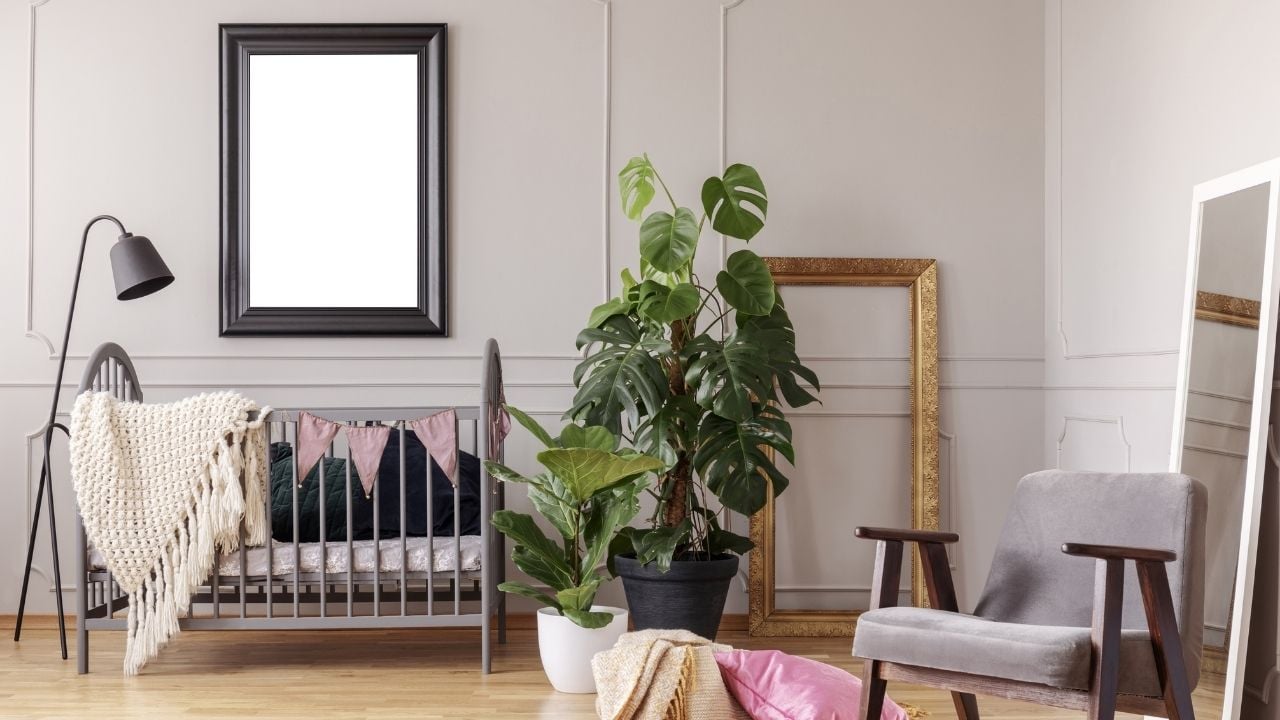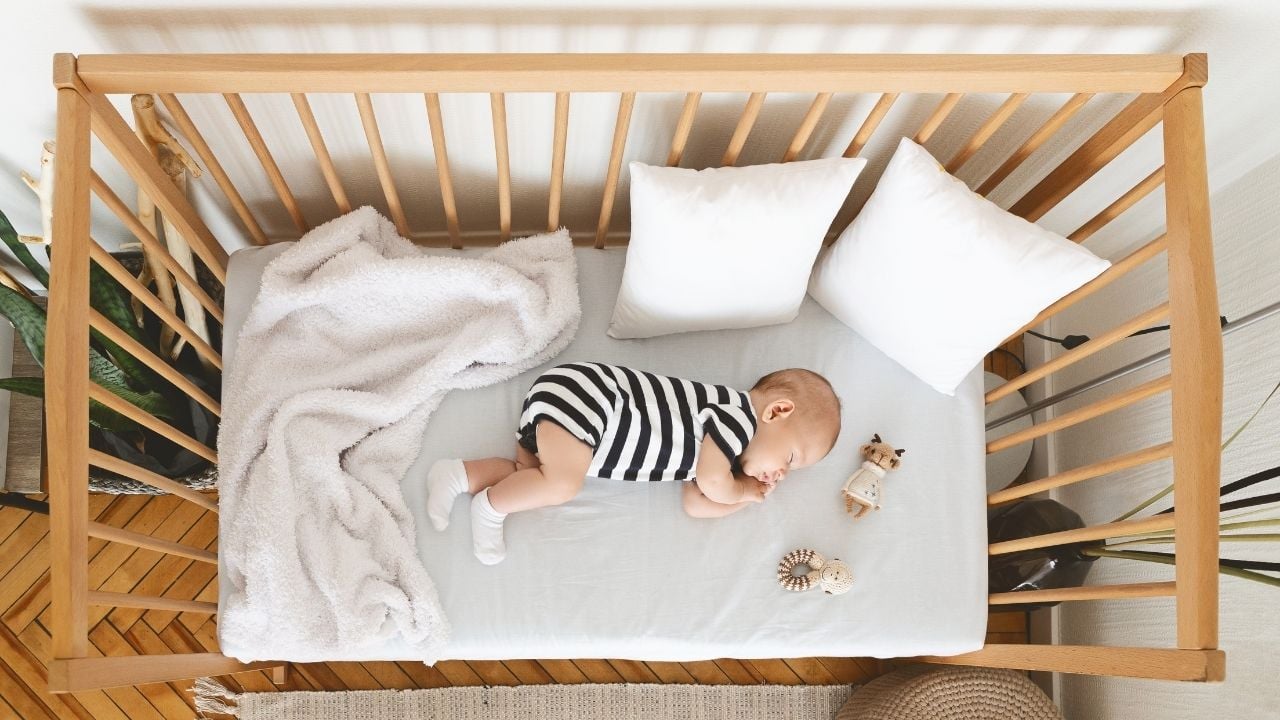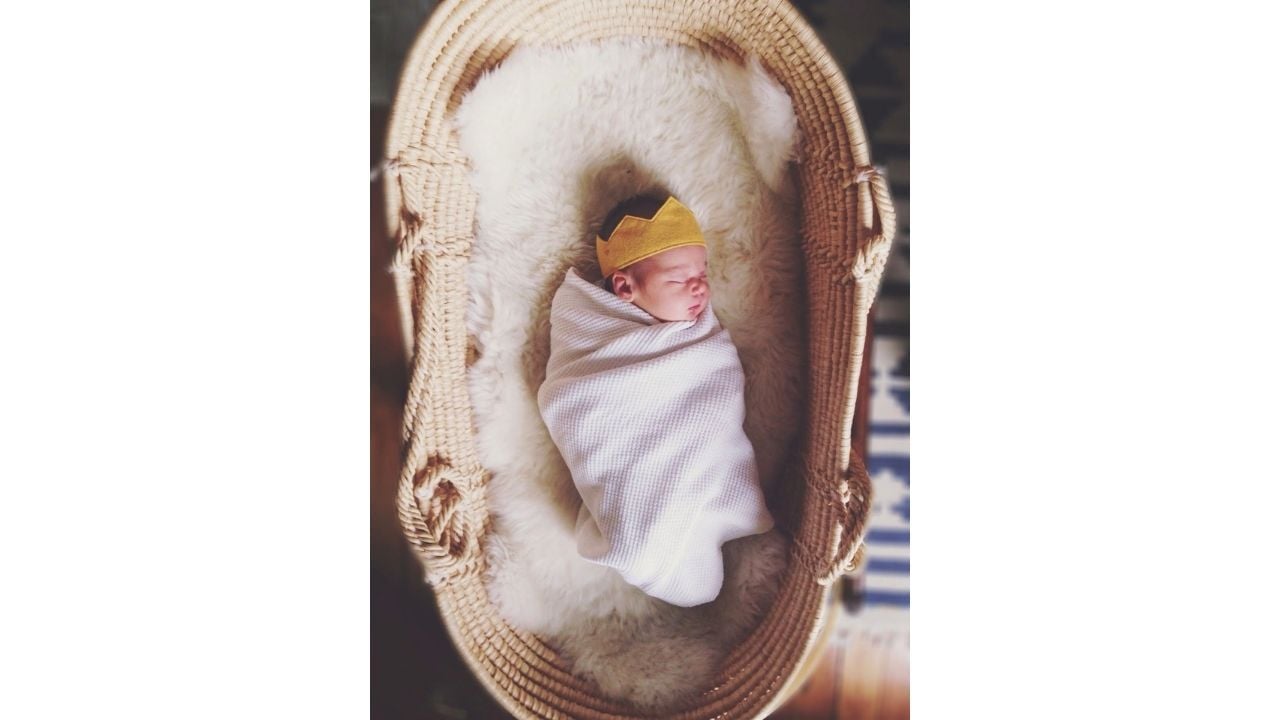Did you spend hours planning the nursery and scrolling online for decor ideas when you were pregnant? Then there’s the adorable monthly milestone photos, with newborns snoozing peacefully in Moses baskets or pillow-y baby loungers. But not all of those cute pics you double-tap on Instagram or save to Pinterest are safe to replicate at home.
By sharing some of these trendy products and nursery set-ups, influencers are doing a huge disservice to new parents who get the impression that this is what ideal motherhood, or typical nurseries, should look like. How can it be unsafe if “everyone” else does it this way, right?
Wrong, says Elizabeth Keys, a registered nurse and assistant professor at the School of Nursing, University of British Columbia, Okanagan. “Those idealized, perfectly styled nurseries might be nice to look at, but they’re not safe.” Keys adds that these pics can also “add a lot of pressure on parents to maintain that perfect image, when in reality that’s very hard to do.”
Many of these inspirational nursery decor images are putting style before safety, says Alanna McGinn, a sleep consultant and founder of Good Night Sleep Site.
“We are forgoing safe sleep spaces and including obvious sleep hazards all for a pretty Instagram picture,” McGinn says. Even if it’s just for the picture and parents are removing pillows and blankets for overnight sleep, for example, or supervising their baby the entire time they’re napping, McGinn says these pictures are portraying a false reality and influencing others to do the same, perhaps without safety precautions or supervision.
Here are some of the most popular nursery design trends you’ll want to think twice about before replicating in your own little one’s room.
1. Moses baskets
Photo: Today’s Letters via Pinterest
A Moses basket should only be used for sleep if it meets the safety requirements of bassinets as outlined by Health Canada, which means it must have clearly labelled age or weight limits, breathable sides, a sturdy bottom, smooth surfaces with no hardware sticking out, and a firm, snug mattress that when pushed against the side of the bassinet, doesn’t leave a gap.
The concern with many Moses baskets is that the mattress may be too soft, and there could be spacing between the mattress and sides that an infant might roll into and suffocate, says paediatrician Michelle Ponti, a member of the Canadian Paediatric Society’s Public Education Advisory Committee. “Although they might look pretty and trendy, if they don’t meet safety standards, they are not recommended at all.”
Recently, Health Canada recalled one style of Moses basket due to risk of injury. The basket in question was determined to be unstable and had the potential to tip over. A ribbon on the hood of the basket was also deemed to be a strangulation hazard. If you’re considering this type of bassinet, make sure the one you purchase meets Health Canada’s safety standards and isn’t included in any recalls.
The safest place for your baby to sleep is alone, on their back, and in a crib, cradle or bassinet that meets Health Canada guidelines.
Your little one also doesn’t need any additional blankets aside from a well-fitting swaddle (the one pictured above is too loose and too high), and there’s no reason to line a bassinet with a throw like a sheepskin, as many of us have done for photos. “For anything that your baby is sleeping on, you want it to be a smooth, flat surface,” says Keys. “Those sheepskin throws don’t stay flat, and they could be a risk for suffocation. It reduces the airflow.”
2. Sleep pods or baby nap loungers
Despite safety alerts, recalls, and Health Canada issuing an outright ban on selling the DockATot in Canada, many parents continue to use baby nests or sleep pods as a place for their baby to sleep. (Some even place them in an adult bed or inside the crib, as in the picture above!) Adding to the confusion, you can still buy DockATots in the US, so you may see them on social media being used by American moms, which normalizes them as an acceptable infant sleep location. (However, they are part of a group of baby products being phased out by the Consumer Product Safety Commission by 2022.)
Plus, Snuggle Me Organic loungers, which look a lot like the DockATot, and other soft-sided travel beds or in-bed sleepers, are still available to buy in Canada.
“This is not a safe sleep space, and because of the soft surface, and lack of high sides, a baby should not be sleeping in any type of nap lounger,” says McGinn. The soft, padded sides of these pods are a suffocation risk for a baby who rolls or turns their head to the side. Plus, they’re often placed on top of tables, furniture, or right in the bed with parents, where it’s so easy for them to be knocked over—baby and all.
3. Heavy frames or shelving over the crib

Photo: iStock/KatarzynaBialasiewicz
Nursery pictures often show big, framed artwork or gallery walls installed over the crib or changing table, where a baby could pull them down. “You see these trendy design ideas, but they are not childproof,” says Ponti. Over time, she explains, things shift in a home and there’s a chance the nail could come loose, or the item falls because it wasn’t secured properly. Plus, as experienced parents know, once your child learns to stand in the crib and reaching for things, they might pull mirrors or frames down on top of themselves, risking injury.
“It’s best for parents to avoid putting anything above, or within arm’s reach of the crib, and that includes any furniture or wall hangings,” says Keys.
Instead, parents could opt for a safer alternative such as wallpaper, an accent wall, or something painted right onto the wall, like a mural. Wall stencils or decals are another option, though Ponti cautions that she has also seen decals being pulled off the wall by persistent babies and toddlers. (They would then become a choking hazard.) If you do use decals, it’s best to place them higher up on the wall, and out of reach.
4. Crib bumpers
Crib bumpers—even those that are advertised as breathable, like mesh bumpers—are not recommended, and both Health Canada and the Canadian Paediatric Society have warned against using them due to the risk of suffocation and strangulation. Older babies may also stand or crawl up on top of a squished-down bumper, using it as a step and making the crib less safe.
Crib bumpers are also unnecessary. Newer cribs are built with the bars closer together (and in compliance with Health Canada recommendations) so there’s no concern about baby limbs or heads getting stuck between the bars. Still, crib bumpers can be found for sale at baby boutiques and big box stores, and some influencers have bought into them for aesthetic reasons.
“Just because a store is selling it, doesn’t mean these things are safe for infant sleep, and parents need to be aware of that,” says Keys.
If you’re using bumpers mainly to keep pacifiers from falling out of the crib, consider scattering multiple soothers in the crib for your baby to find each night.
5. Blankets, pillows and stuffed animals in the crib or bassinet

Photo: iStock/Prostock-Studio
Many nursery pics are styled with a baby blanket draped on the side of the crib, and several throw pillows or cute stuffies within the crib itself. But this is exactly the opposite of how health experts say an infant’s sleep space should look.
“The crib has to be kept absolutely bare—that’s the recommendation; no exceptions,” says Ponti. “Once we start thinking ‘oh, we just want this to be cute and whimsical and pretty,’ it’s just posing an extra risk for that infant.” These items might soften the space and make it look cozier, but they aren’t necessary, and they actually increase the risk of Sudden Infant Death Syndrome (SIDS).
“The same goes for stuffed animals,” says Ponti. “Not until a child is much older and is able to have better head and neck control, and sleeping in more of a toddler bed, would you be able to consider some type of transitional object, like a stuffed animal for security.”
Even if these items are placed in the crib solely for a photo, or at times the baby isn’t in the crib, there’s always the chance parents or another caregiver might forget to remove them before leaving the baby in the crib, says Keys.
If you want to add some visual interest to the crib, McGinn suggests playing with the colour or design of the fitted mattress sheet.
6. Fairy lights, garlands, crib canopies, and bunting
While felt bunting and paper garlands are lightweight, they’re still a hazard if they fall into the crib. “String lights and that sort of thing should be kept away from the crib and definitely always out of reach,” says Keys, who says these are a strangulation risk, along the same lines as dangling blind cords.
Beware of the power cords to nightlights, sound machines, and OK-to-wake toddler clocks as well.
That dreamy-looking canopy or tent flowing over the corner of a crib could quickly become a nightmare for parents. The loose fabric is a suffocation risk and any strings or ties are strangulation hazards. It doesn’t matter if the fabric is draped outside the crib bars—if it’s within reach, it’s a definite danger.
Instead, look for safer ways to make a statement in the nursery. A dramatic pendant light or chandelier could be a great focal point. A rug, whether layered over existing carpet or hardwood, is another way to create warmth and add personality. Macrame wall hangings are great, but don’t place them within reach of the crib.
7. Putting your crib near a window
Beware of arranging the furniture layout so that the crib is near a window. As your baby grows into a toddler, you’ll find out that cribs aren’t escape-proof—some little ones really love to climb. (This is especially dangerous if your windows open wide, and there’s only a thin screen keeping them inside.) There are other dangers to consider around the window, including dangling blind cords or drapery.
“Depending on the window, there may also be some temperature changes that could be difficult to manage,” says Keys. Drafty windows in winter, or a window air conditioning unit in summer, could cause issues at that location.
While it’s true that a baby who is a little too cold is safer than an overheated baby, it something to be mindful of. Sometimes, says Keys, if the room is chilly, “parents might inadvertently respond by adding too many layers.”
8. Plants in the nursery
Adding greenery to a room is one of the easiest ways to liven up a space and add a pop of colour, and of course potted plants, hanging plants, and succulents are super trendy right now. However, while that fiddle-leaf fig tree in the nursery might be cute for the first couple of months, once your baby can crawl over, make a mess with fistfuls of dirt, and possibly pull the plant over on themselves, you might rethink this particular plan. (Plus, fiddle-leaf figs—also known as a philodendron—can be highly toxic to children if the leaves are ingested.)
If you do add any houseplants to your child’s nursery, ensure they are placed out of reach, and that they can’t fall on your baby. Avoid any that are poisonous or known to cause skin irritation. (You might consider artificial plants instead, if you really love the look.)
With all these considerations in mind, the safest sleep space for a baby is pretty boring to look at, admits Keys. But it’s important that parents prioritize safety first, and design—as well as how things look on social media—after. “To your baby, it doesn’t matter if their nursery is perfectly styled or not,” she says.
When it comes to baby-proofing your nursery, perhaps minimalism should be the only design trend we attempt to emulate.
